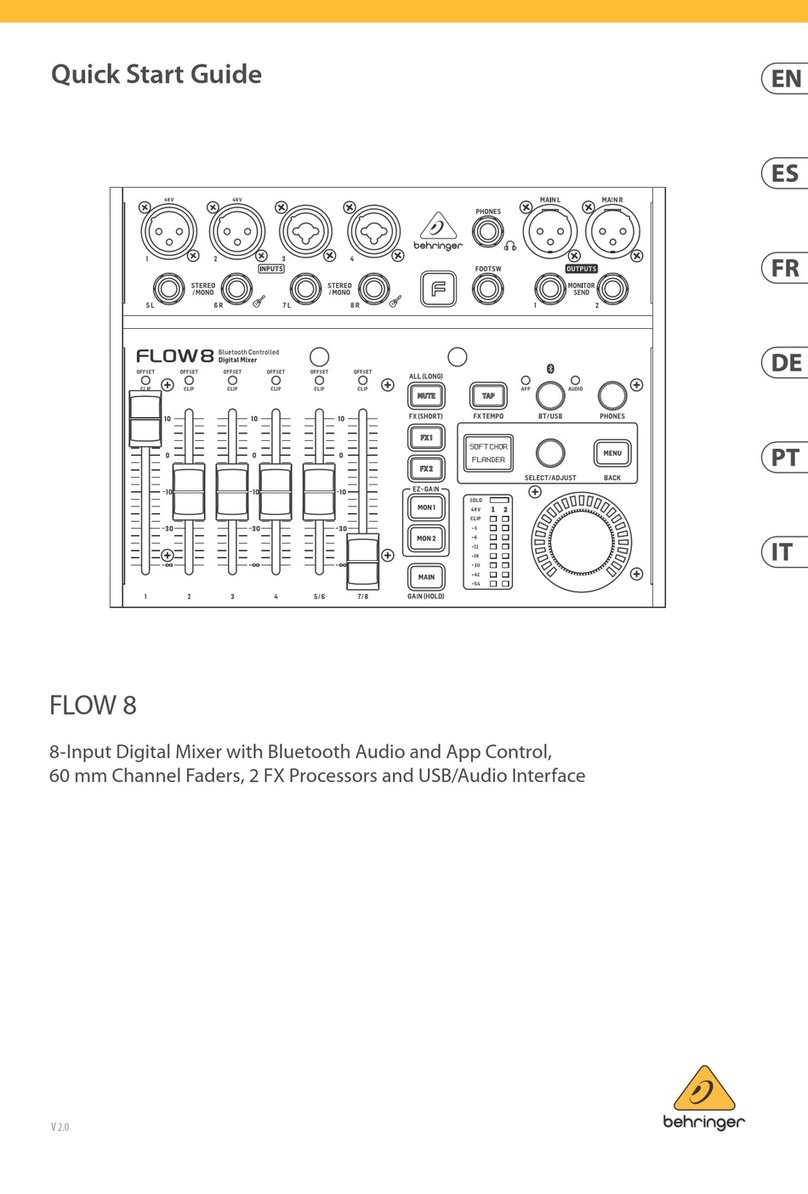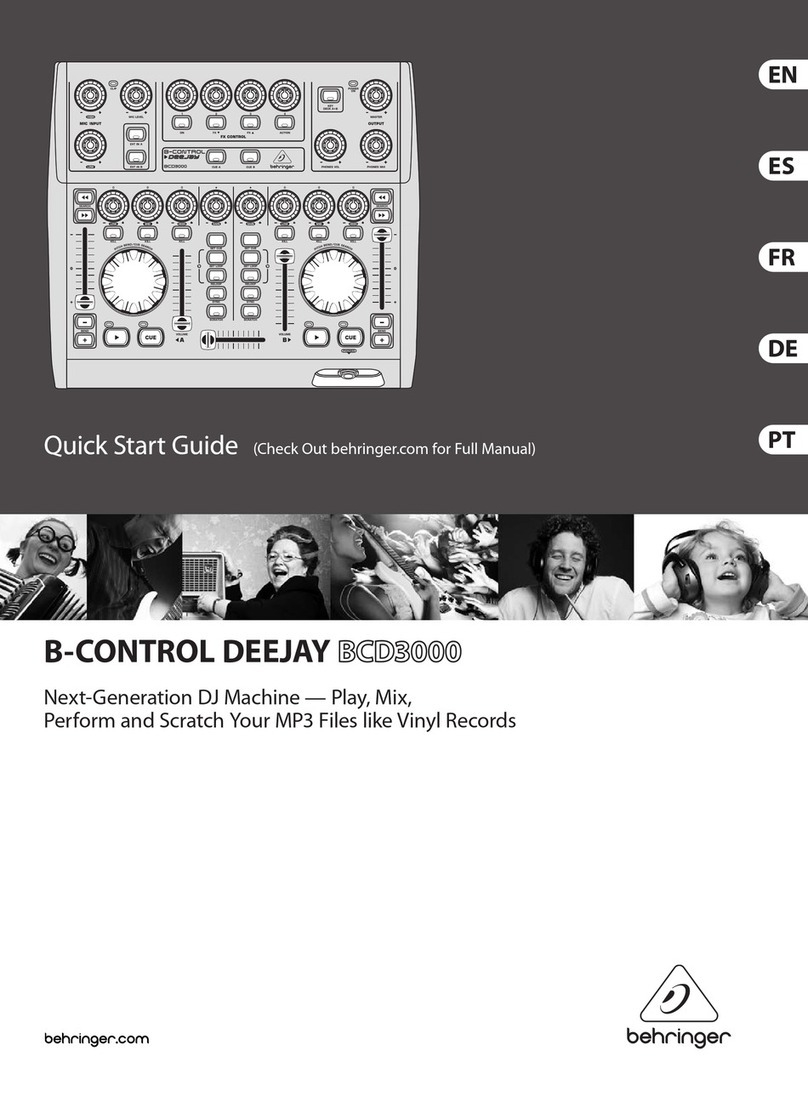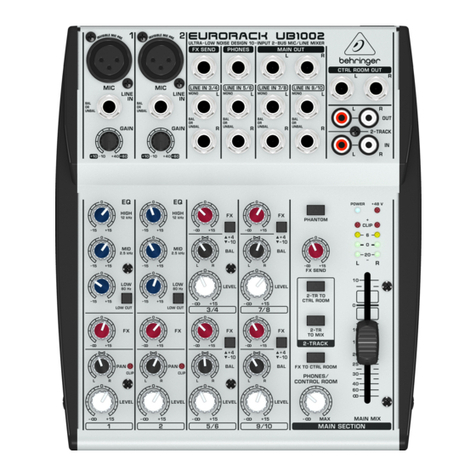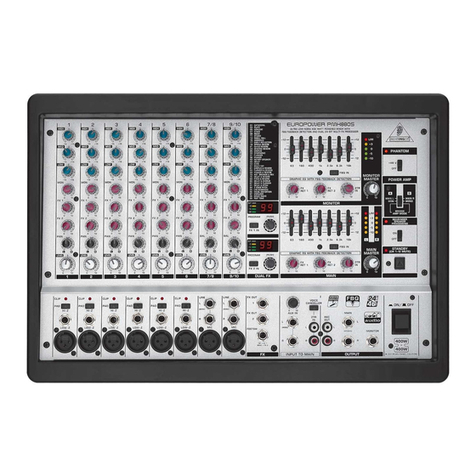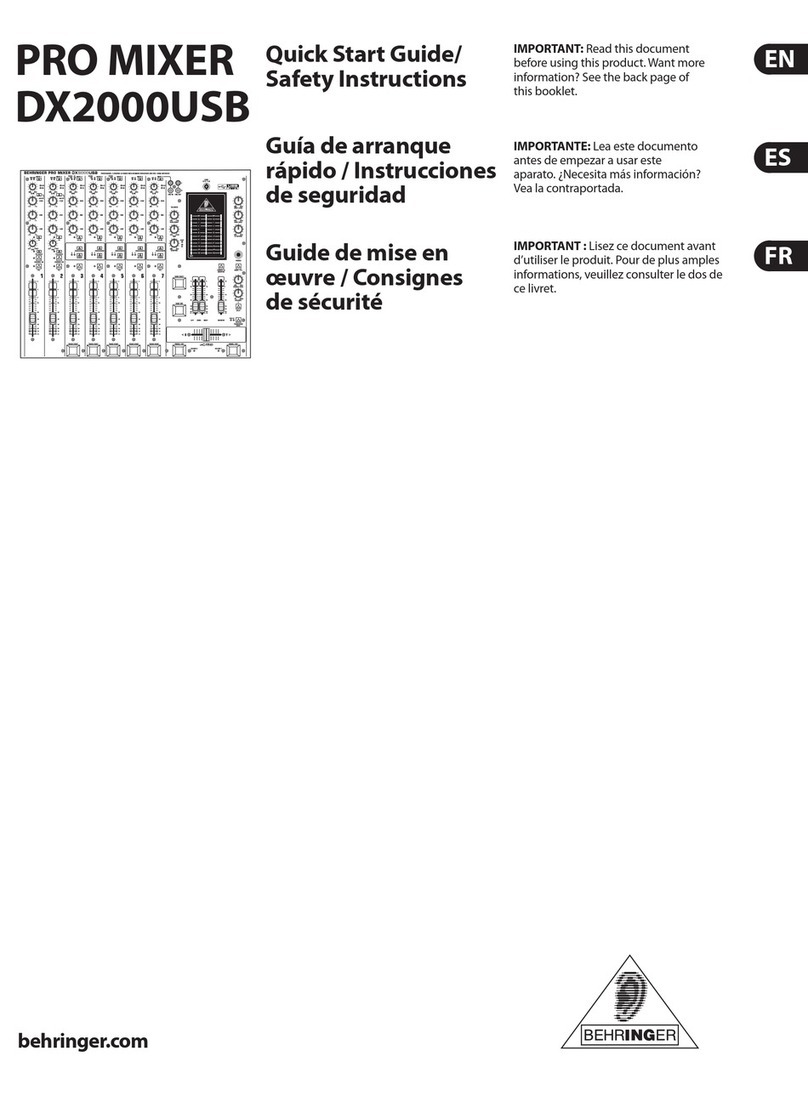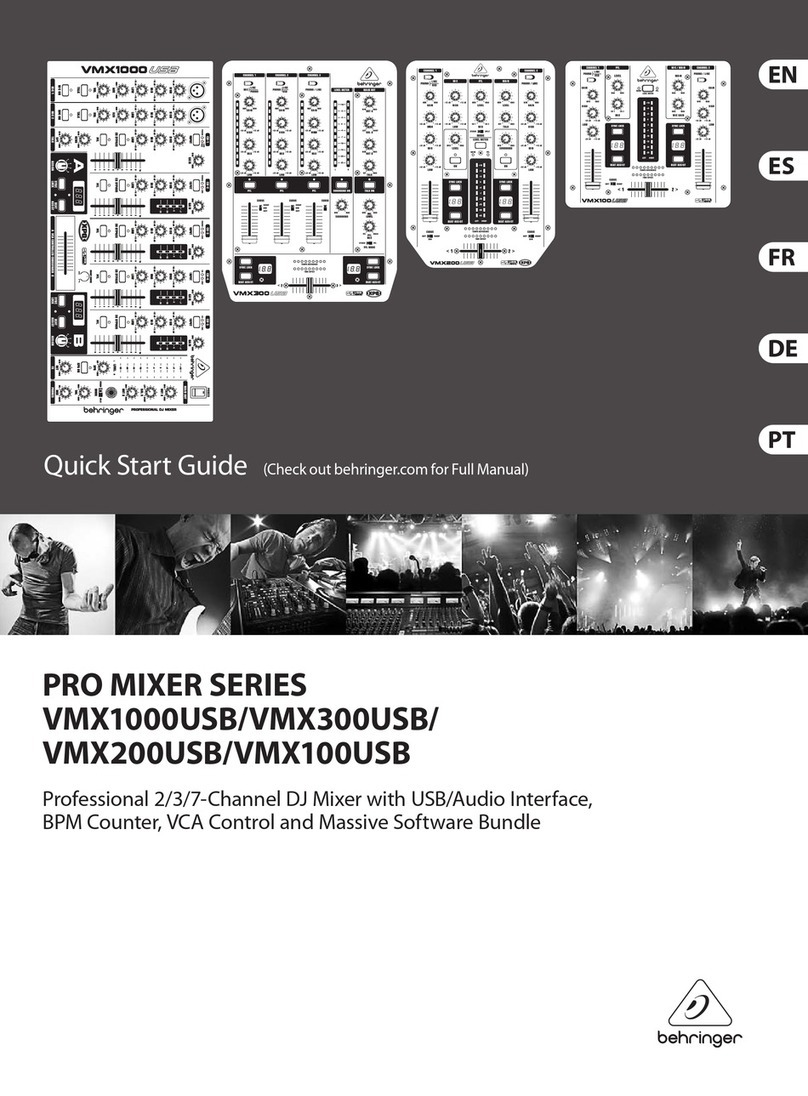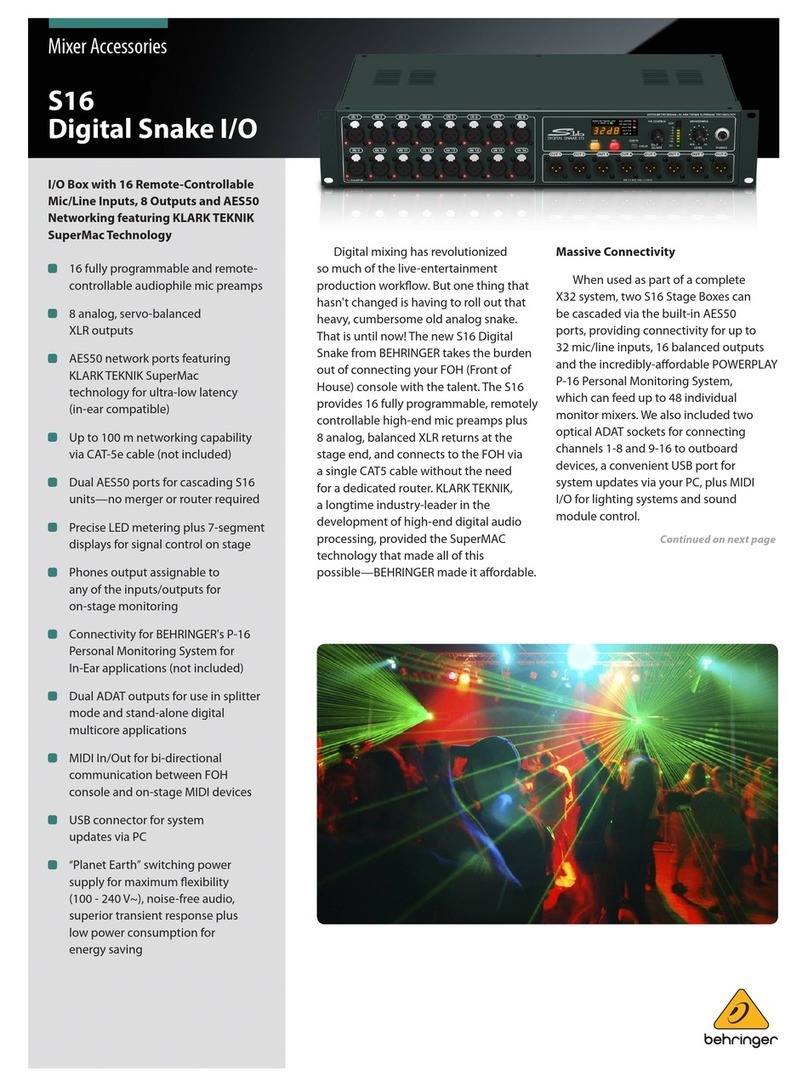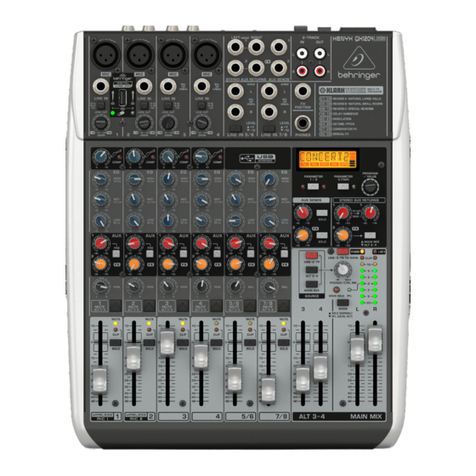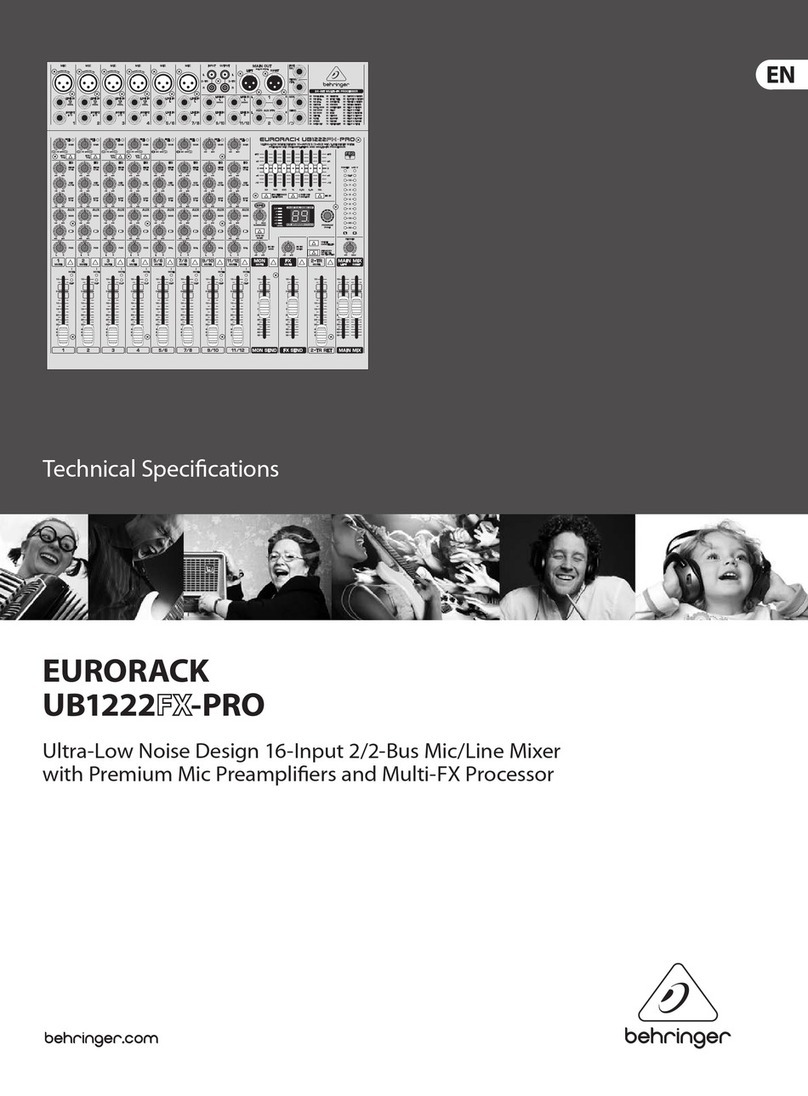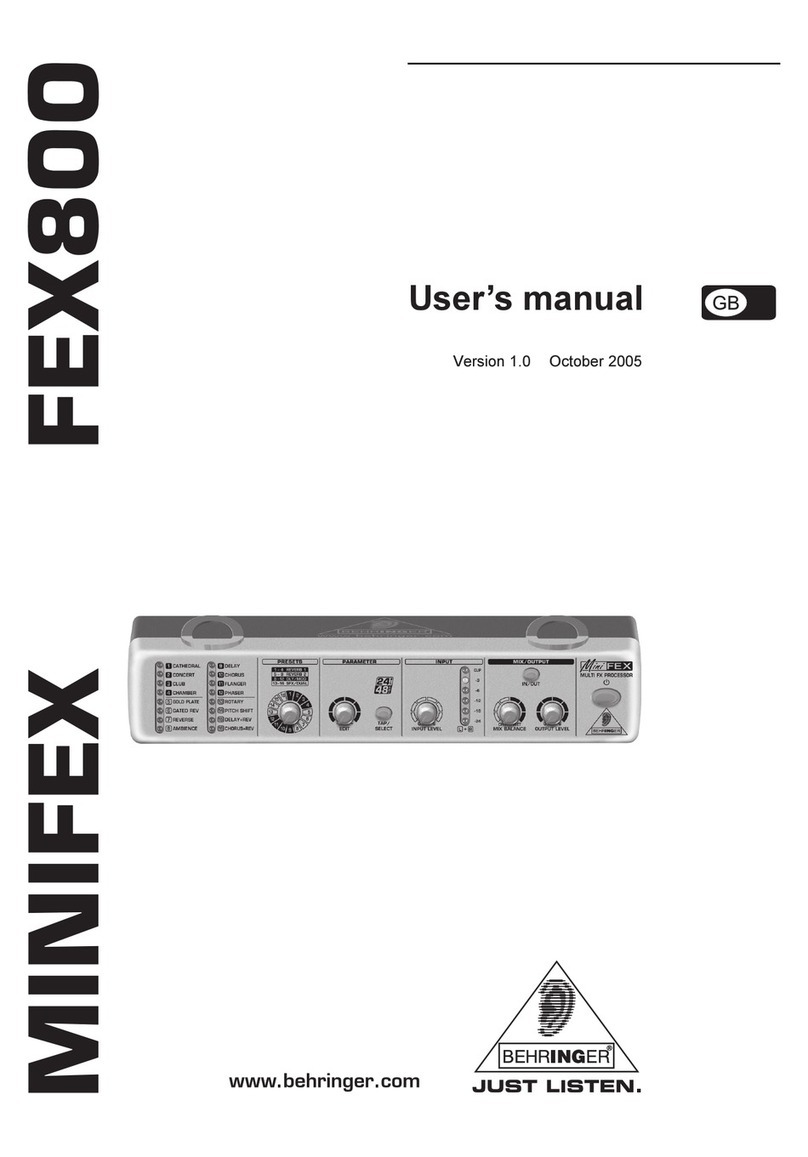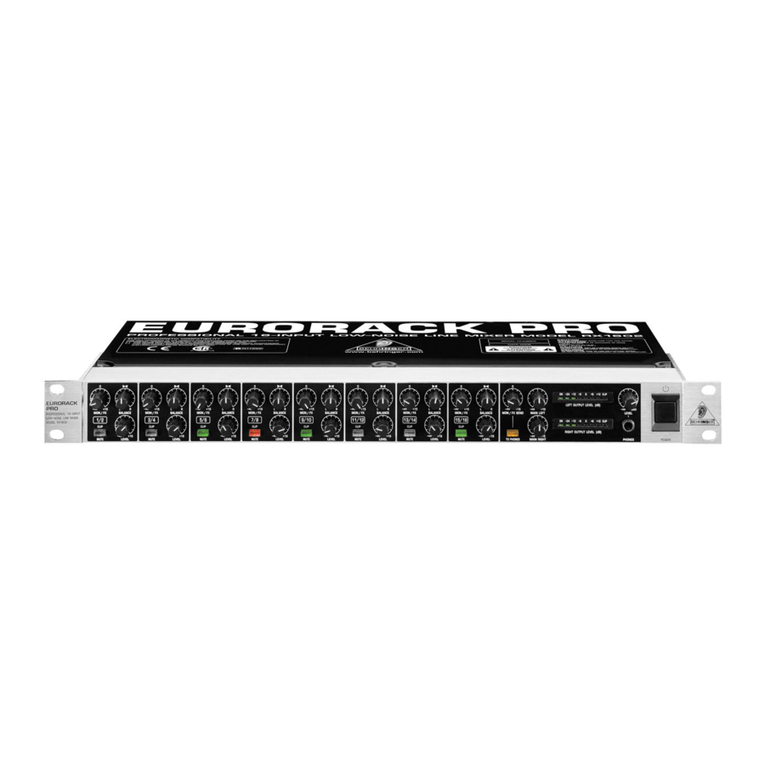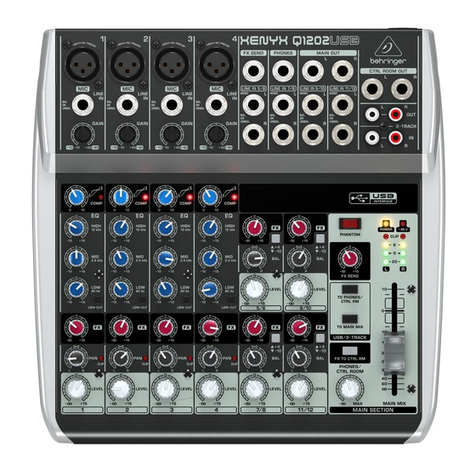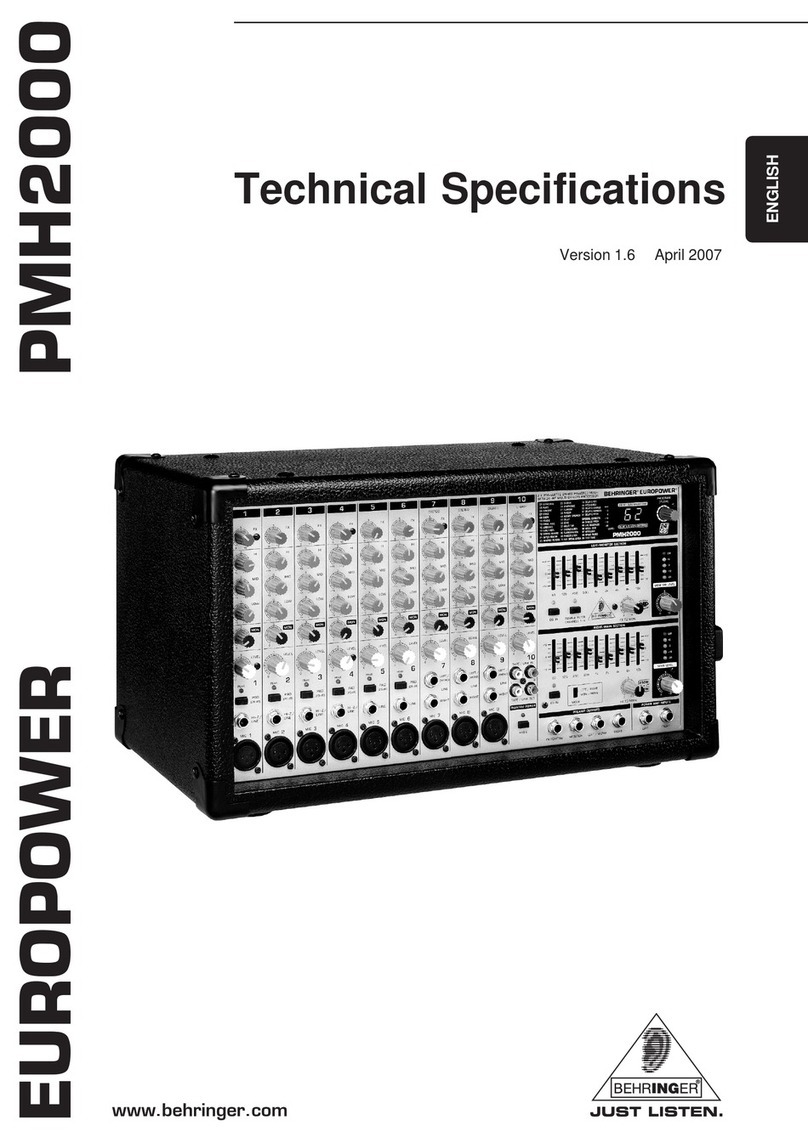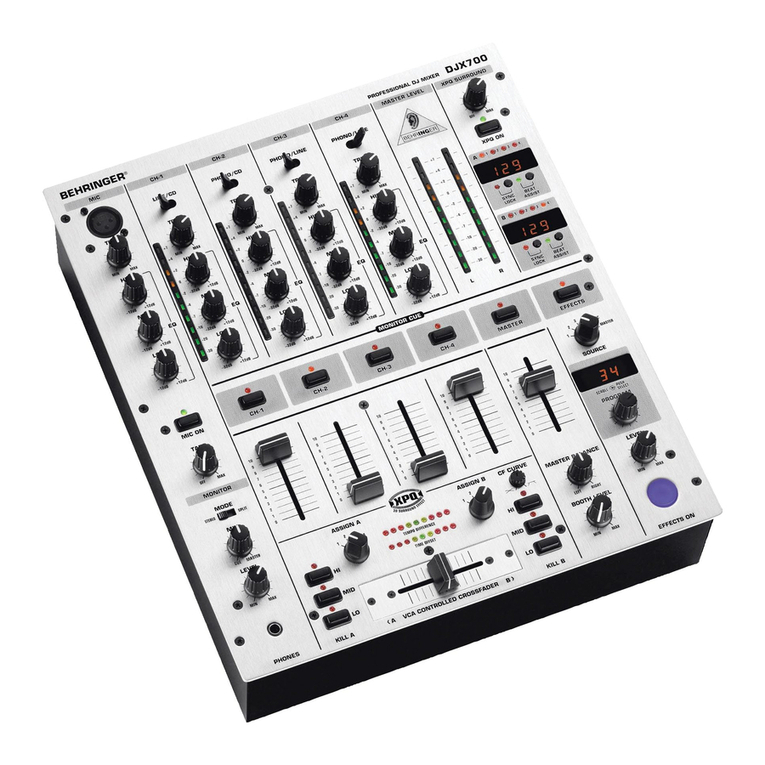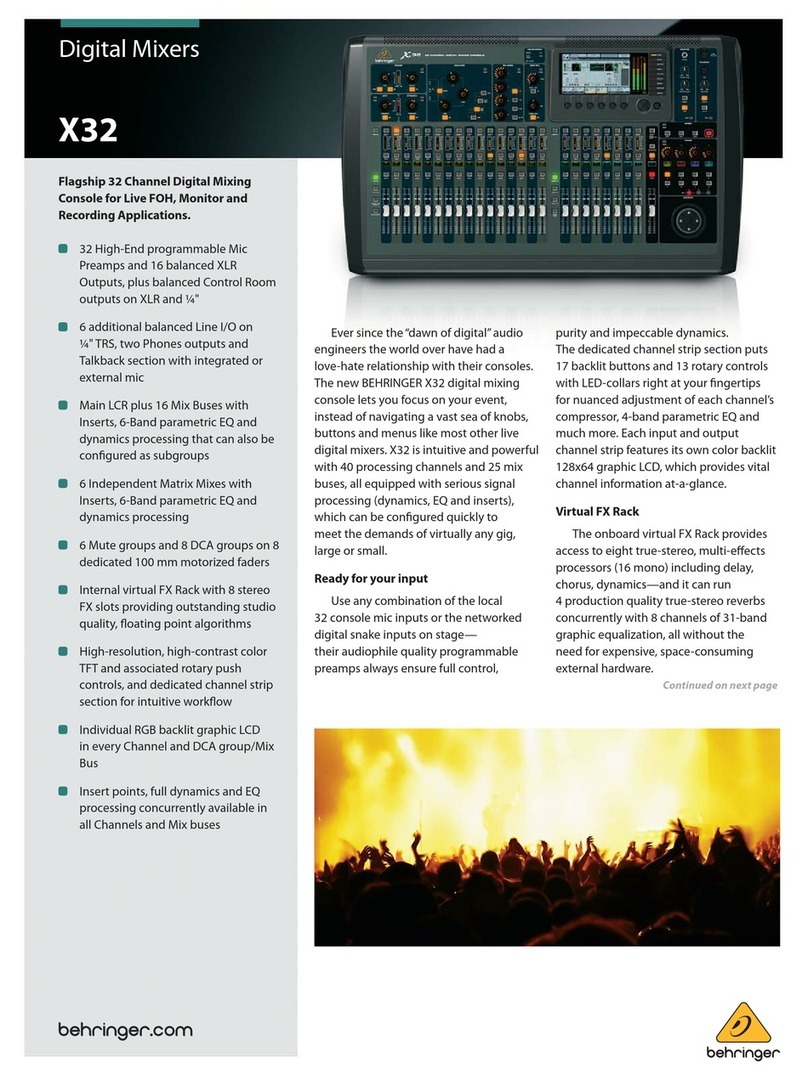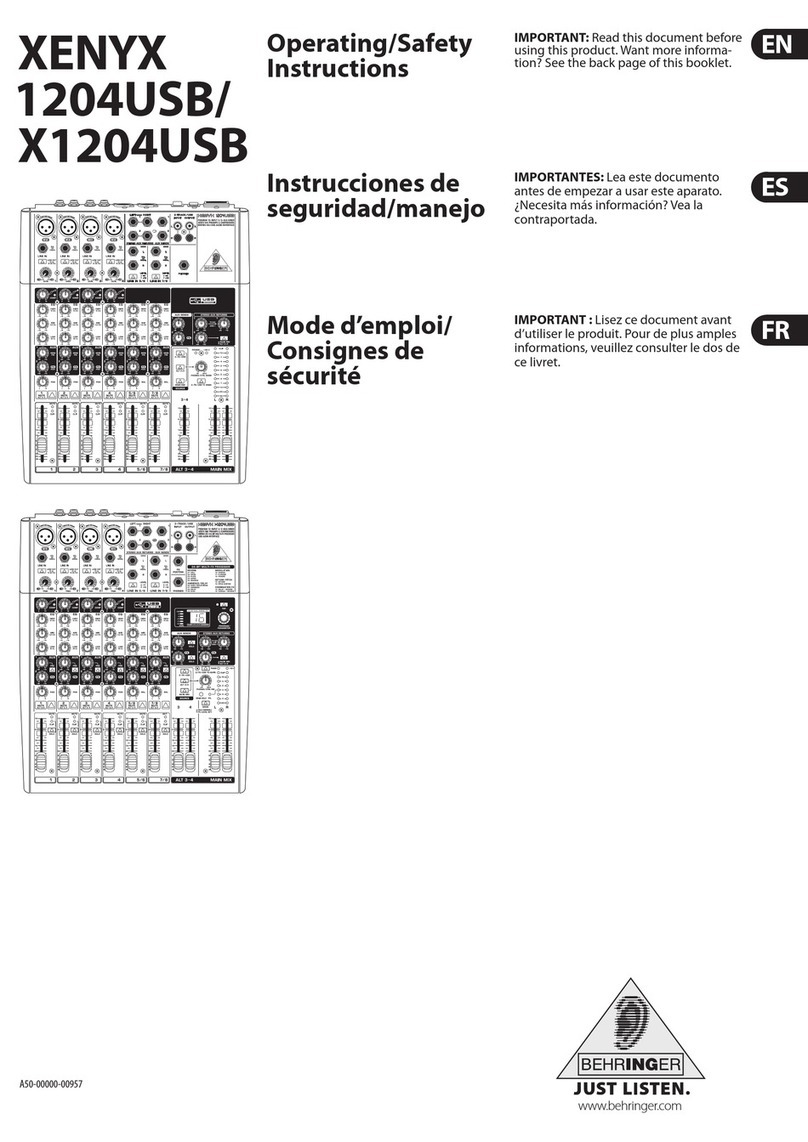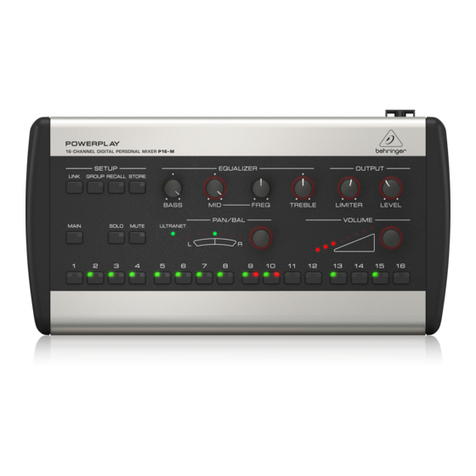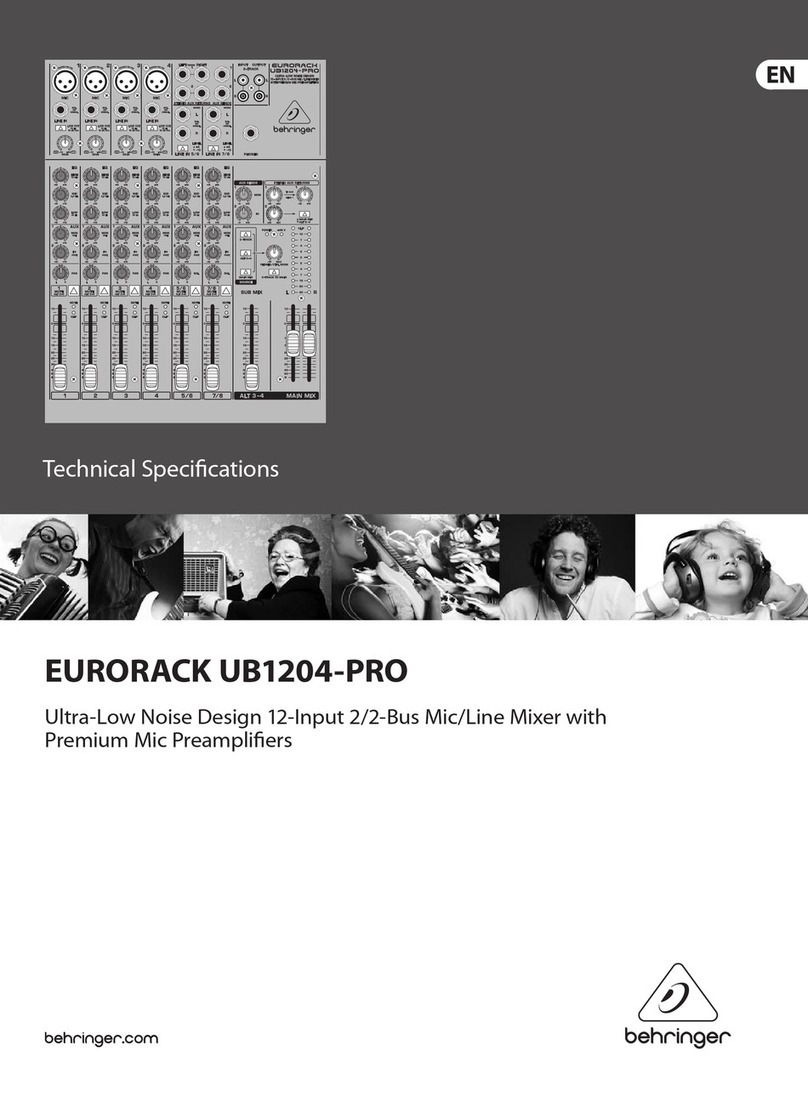4
EURORACK UB1622FX-PRO/UB1832FX-PRO/UB2222FX-PRO/UB2442FX-PRO
y ur headph nes r l udspeakers. Turn the MAIN
MIX faders and ph nes c ntr l in the main secti n
fully d wn bef re y u switch n the unit. Always be
careful t set the appr priate v lume.
1.1 General mixing console functions
A mixing console fulfils three main functions:
sSignal pr cessing:
Preamplificati n
Microphones convert sound waves into voltage that has
to be amplified several-fold then, this voltage is turned into
sound that is reproduced in a loudspeaker. Because micro-
phone capsules are very delicate in their construction,
output voltage is very low and therefore susceptible to
interference. Therefore, mic signal voltage is amplified
directly at the mixer input to a higher signal level that is less
prone to interference. This higher, interference-safe signal
level has to be achieved through amplification using an
amplifier of the highest quality in order to amplify the signal
and add as little noise to it as possible. The IMP Invisible
Mic Preamp performs this role beautifully, leaving no traces
of noise or sound coloration. Interference that could take
place at the preamplification level could affect signal quality
and purity, and would then be passed on to all other
devices, resulting in inaccurate sounding program during
recording or playback.
Level-setting
Signals fed into the mixer using a DI-box (Direct Injection) or
the output of a sound card or a keyboard, often have to be
adjusted to the operating level of your mixing console.
Frequency resp nse c rrecti n
Using the equalizers found in each channel strip, you can
simply, quickly and effectively adjust the way a signal
sounds.
Effects mixing
In addition to the effects processor contained in your mixer,
using the insert connectors on the mono channels and
both aux busses lets you insert additional signal processors
into your signal path.
sSignal distributi n:
Individual signals adjusted at each channel strip are laid
out at the aux sends and returns, and are either fed into
external effects processors or fed back to the internal
effects processor. Then, the signals are brought back into
the main mix either via the aux return connectors or via
direct internal wiring. The mix for the on-stage musicians is
also created using the aux sends (monitor mix). Similarly,
for example, signals for recording equipment, power ampli-
fiers, headphones and 2-track outputs can also be taken.
sMix:
All other mixing console functions fall under this vital category.
Creating a mix means primarily adjusting the volume levels
of individual instruments and voices to one another as well
as giving them the appropriate weight within the overall
frequency spectrum. Likewise, youll have to sensibly
spread individual voices across the stereo image of a signal.
At the end of this process, adjusting the level of the entire
mix to other equipment in the signal path is required (e. g.
recorder/crossover/amplifier).
The control surface of BEHRINGER mixing consoles is opti-
mized in such a way that these functions become easy to fulfil
while the signal path remains simple to follow.
1.2 The users manual
The users manual is designed to give you both an overview of
the controls, as well as detailed information on how to use them.
In order to help you understand the links between the controls,
we have arranged them in groups according to their function. If
1. INTRODUCTION
Congratulations! In purchasing the BEHRINGER EURORACK
you have acquired a mixer whose small size belies its incredible
versatility and audio performance.
The BEHRINGER EURORACK mixing console offers you
premium-quality microphone preamplifiers with optional phantom
power supply, balanced line inputs and the ability to connect
external effects devices. Because of its extensive and carefully
thought-out routing possibilities, your EURORACK lends itself
equally to both live and studio use.
IMP Invisible Mic Preamp
The microphone channels are fitted with BEHRINGERs brand
new high-end IMP INVISIBLE MIC PREAMPs that boast the
following features:
s130 dB dynamic range for an incredible amount of headroom
sA bandwidth ranging from below 10 Hz to over 200 kHz for
crystal-clear reproduction of even the finest nuances
sThe extremely low-noise and distortion-free circuitry gua-
rantees absolutely natural and transparent signal repro-
duction
sThey are perfectly matched to every conceivable micro-
phone with up to 60 dB gain and +48 volt phantom power
supply
sThey enable full utilisation of the greatly extended dynamic
range of your 24-bit/192 kHz HD recorder, thereby main-
taining optimal audio quality
In addition, your BEHRINGER EURORACK offers an
effects processor equipped with 24-bit A/D and D/
A converters. The processor is fitted with the effect
algorithms from our tried and tested 19" multi-effects
device, the VIRTUALIZER PRO DSP2024P. 99 presets are
available providing first-class room simulations, delay and
modulation effects, as well as compression, tube distortion and
many other effects, all with stunning audio quality.
The mixing consoles of the PRO series feature a
state-of-the-art integrated switch-mode power
supply. One of the great advantages is that
(compared to conventional circuits) a switch-mode
power supply adapts to mains voltages between 100 and 240
volts automatically. Furthermore, due to its much greater
efficiency, it consumes much less energy than a conventional
power supply unit.
FBQ Feedback Detecti n System
The FBQ Feedback Detection System integrated
into the graphic EQ of your UB1832FX-PRO is
one of this mixers most outstanding features.
This ingenious circuitry lets you immediately
recognize and eliminate feedback frequencies. The FBQ
Feedback Detection System uses the LEDs in the frequency
band faders of the graphic EQ to indicate the critical frequencies.
This way, what once used to be a labor-intensive search for
feedback frequencies is now an activity that even a child could
master.
V ice Canceller
We have added another useful feature to the
EURORACK UB1832FX-PRO: the Voice Canceller.
The Voice Canceller is a filter circuitry that filters out
vocal portions from a track. Therefore, this mixing
console is ideally suited for use as a karaoke machine. This
feature is also an optimal solution for singers who need
accompanying music for their rehearsals.
CAUTION!
+We sh uld like t draw y ur attenti n t the fact that
extreme v lumes may damage y ur hearing and/ r
2. CONTROL ELEMENTS AND CONNECTORS
